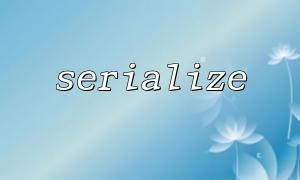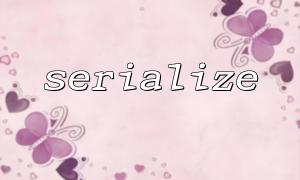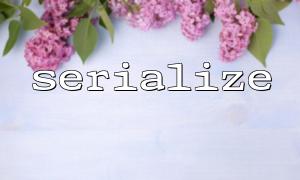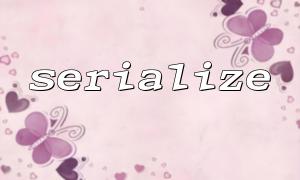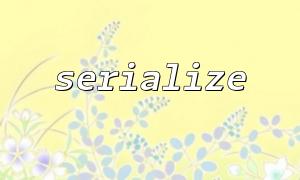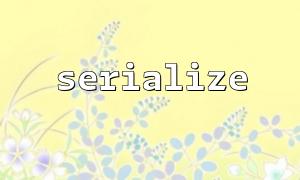In PHP, clone is a method for creating copies of objects. However, in some cases, there may be some undesirable errors or side effects when using clone to copy objects. These errors are usually related to references or resources in objects. To avoid these problems, we can use PHP's serialize function to help us avoid these errors.
This article will explain in detail how to use the serialize function to resolve possible errors when cloning an object.
In PHP, when we need to copy an object, we usually use the clone keyword. A cloning object creates a new object and assigns the property value of the original object to the new object. This may seem simple, but if an object contains attributes of a reference type (such as an array, object, or resource) then these properties can cause problems because the reference type maintains a reference to the original object during cloning.
Here is a simple example of cloning an object:
class Person {
public $name;
public $friends = [];
public function __construct($name) {
$this->name = $name;
}
public function addFriend($friend) {
$this->friends[] = $friend;
}
}
$original = new Person("John");
$original->addFriend("Alice");
$original->addFriend("Bob");
// Cloning an object
$clone = clone $original;
In the example above, when we cloned a Person object using the clone keyword, the $original and $clone objects share the same friends array, which means that if we modify the friends array in the clone , the original friends array will also be affected. This behavior is not usually what we want.
As mentioned earlier, objects in PHP may contain attributes of reference types. When using clone , PHP performs shallow copy by default, meaning that the original object and cloned object share the same data for attributes of reference types such as arrays, objects, and resources. This can lead to some unexpected side effects.
For example, when modifying a certain attribute of a cloned object, the properties of the original object will also change, and vice versa. This behavior can lead to errors that we cannot expect when dealing with complex objects.
To solve the shared reference problem caused by clone , we can use serialize and unserialize functions to make deep copy. serialize converts the object to a string, and unserialize reconverts the string to an object. Using this approach avoids the above problems by ensuring that the objects we copied do not share any attributes of reference type.
Here is how to use serialize and unserialize to avoid the problem of shared references when clone :
class Person {
public $name;
public $friends = [];
public function __construct($name) {
$this->name = $name;
}
public function addFriend($friend) {
$this->friends[] = $friend;
}
}
$original = new Person("John");
$original->addFriend("Alice");
$original->addFriend("Bob");
// use serialize and unserialize Make a deep copy
$clone = unserialize(serialize($original));
// 修改Cloning an object的朋友列表
$clone->addFriend("Charlie");
// 输出原始对象andCloning an object的朋友列表
echo "Original friends: " . implode(", ", $original->friends) . "\n";
echo "Clone friends: " . implode(", ", $clone->friends) . "\n";
In this example, the friends arrays of $original and $clone objects are completely independent. Even if we modify the friends array in clone , the friends array of the original object will not be affected. This is because serialize and unserialize create a deep copy of the object, and all attributes of the reference type are independently copied.
The serialize function converts the entire object into a string and processes all properties in the object, including those of reference types. When we restore objects through unserialize , PHP creates a new object instance and copies all properties to ensure that they are independent. Therefore, any attributes of reference types, such as arrays or other objects, are not shared between the original and cloned objects.
One advantage of this approach is that it does not rely on the object's __clone method or __sleep and __wakeup methods, but implements deep copy directly through serialization and deserialization.
While serialize and unserialize provide an effective solution, it also has some limitations:
Performance issues : For large objects, the process of serialization and deserialization may be slower, especially when the object has many properties.
Objects that are not serialized : Some objects (for example, resource types or classes that cannot be serialized) may not be serialized by serialize , which may cause errors.
Therefore, when using serialize for deep copying, its advantages and disadvantages should be weighed according to actual conditions.
By using serialize and unserialize functions, we can avoid shared reference issues when cloning objects. This method ensures that the cloned object and the original object's properties do not affect each other by creating a deep copy of the object, especially if the object contains properties of an array or other reference type.
In actual development, using serialize and unserialize is a very effective solution if you need to deal with complex objects and avoid errors during cloning.
If the article involves URL parts, such as API calls, etc., you can replace its domain name with gitbox.net as shown below:
$url = "https://gitbox.net/api/getData";
This way, even in network requests, you can ensure that the URL correctly points to the domain name gitbox.net you specified.
